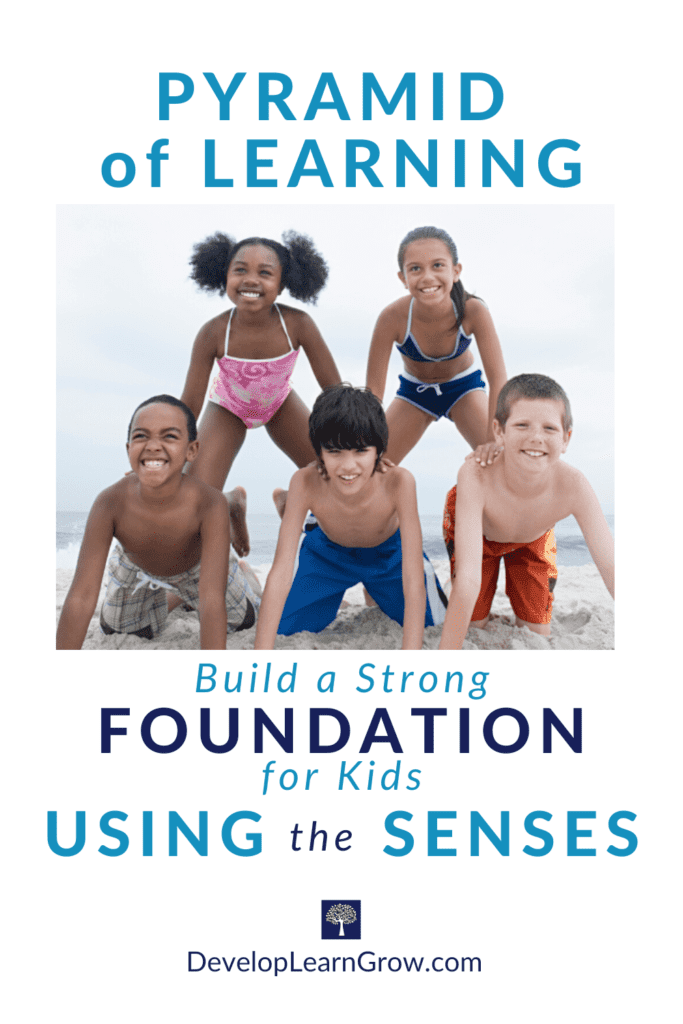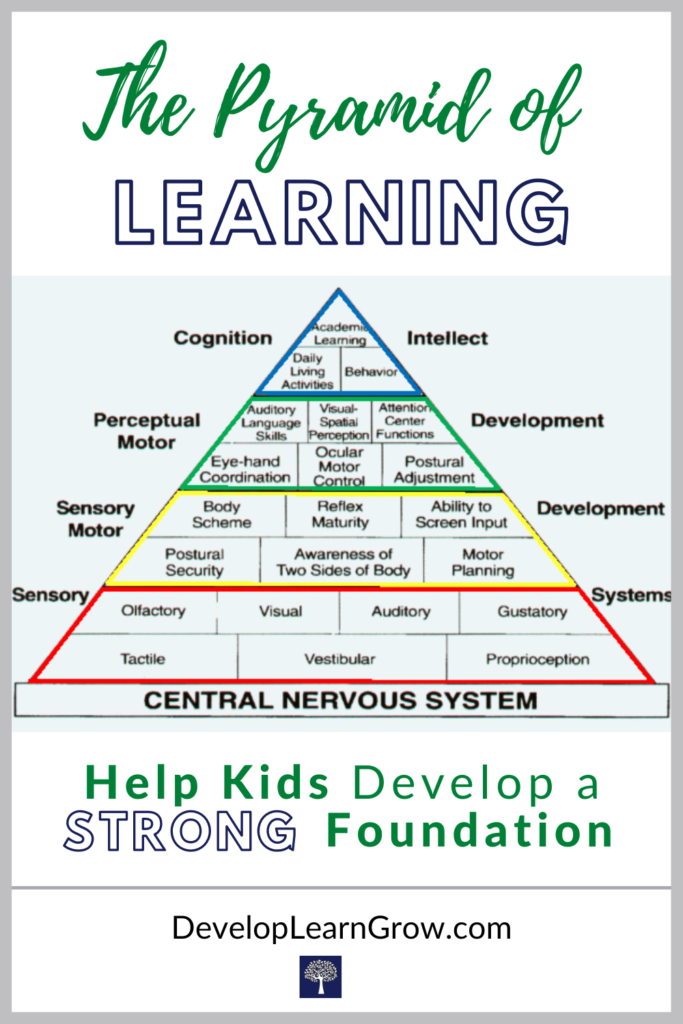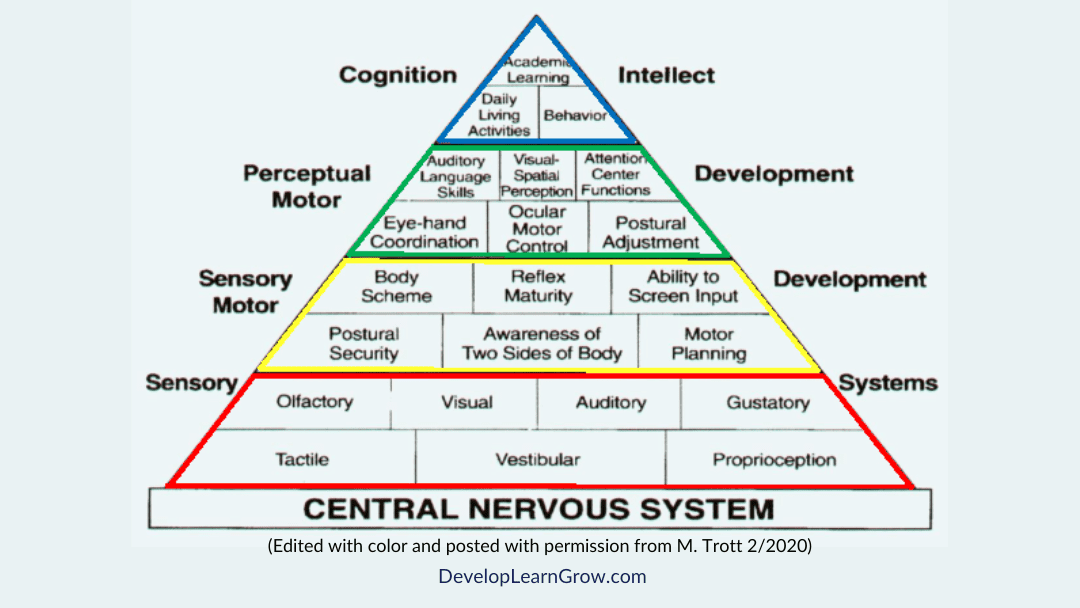The pyramid of learning is a helpful visual for understanding why the sensory systems are so important for children! It shows how the senses are the foundation for many other areas of development. Children’s bodies need a strong foundation of nourishment for the central nervous system [BRAIN!] in order to attend, behave and learn.
As an occupational therapist, the pyramid of learning has been my favorite visual to use with teachers and parents. It shows why childhood PLAY and LEARNING using the sensory systems is SO-INCREDIBLY-IMPORTANT!
I was excited (and nervous) to have to contact one of the original developers of the pyramid, Maryann Trott. I had to gain permission to use the Pyramid as it is on my site, OR to re-create it…
Could I even find her online? If so, would the contact info be correct / updated? How long would I have to wait for a response………..
I was shocked! Maryann Trott, inspirational educator, responded to my email a little over an hour later!! I was so surprised at the quickness of her response, and also super excited she allowed me to use it.
Thank you Maryann for giving me permission to use your lovely visual! The only change I made for now was adding color to each section of the pyramid.
Maryann Trott (special educator) and Kathleen Taylor (occupational therapist) created this visual.
Why the Pyramid of Learning is Important – An Occupational Therapy Perspective
Kids need routine sensory input for their bodies! The more input you provide to the body and the sensory systems… the more input you’re giving to the brain. This creates a strong foundation for learning.
The seven sensory systems are at the base of the pyramid: Tactile (touch), Vestibular (movement), Proprioception (muscle/joint), Olfactory (smell), Visual, Auditory, and Gustatory (taste.)
Sensory Systems 101- Understanding the Hidden Senses explains the first three sensory systems in more detail. The 8th hidden sense is interoception – sensing hunger, thirst, and other internal signals.
The pyramid shows how the sensory systems are an essential part of academic learning. It illustrates the foundation for what a child’s brain NATURALLY needs in order to behave, attend (focus), complete daily tasks, and learn.
The central nervous system is like an extremely fast computer – it’s constantly taking in information (both inside and outside of the body.) It processes and organizes info, and then quickly responds to it.
Adequately processing information in the sensory systems through multi-sensory play and learning supports sensorimotor and perceptual development.

Kids need to use their bodies and senses as much as possible as they play and learn. They need movement, muscle / joint input, and tactile activities. Children need time outside to play, explore, and learn.
A child’s brain and body needs to run, climb, jump, roll, spin and swing. It needs messy, dirty play and opportunities for various textures such as shaving cream, finger paint, sand, and dough.
Auditory input helps develop attention, communication, cognitive, emotional and social skills. Kids need music, singing, books, sounds, and other auditory activities – WITHOUT SCREENS.
Visual input helps children’s brain make sense of what they see. They need bright and contrasting colors when learning, patterns, designs, scavenger hunts, and other visual activities – WITHOUT SCREENS!
Sensory Motor Development on the Pyramid of Learning
A strong foundation of processing input from the sensory systems, helps to build sensory motor skills. Movement and using the muscles helps with balance and core stability.
Adequate core strength is important for sitting upright, for attending, and for using the hands for fine motor tasks.
If kids don’t have adequate core strength and stability, they fatigue quickly… they spend a lot of time moving around, changing position, or propping the body. It’s difficult for the brain to pay attention if the body is working hard to sit upright.
When the core is strong enough, a child sits upright with good posture. Then, the shoulder can help stabilize the arm. With a stable shoulder, the arm and hand can perform fine motor movements more efficiently and without fatigue.
[Check out How a Vertical Surface and Floor Activities Improve Core Stability – help improve shoulder stability with the activities on the free printable. Or, check out 40 Core Strength Exercises for Kids, another free printable available.]
Sensorimotor development continues as functional motor skills develop and daily movements needed for school or self-care tasks become more automatic. Reflexes from birth disappear as more refined coordinated movements develop throughout the entire body.
Body awareness, position words, and an understanding of left-right make following directions and competing school tasks easier.
Motor memory develops which makes forming numbers and letters easier and quicker.
Perceptual Motor Development on the Pyramid of Learning
Perceptual motor development relies on adequate sensory processing and sensorimotor development. Higher level processing and coordination occurs in the brain.
The hand muscles strengthen for improved grasp development. A child’s fingers improve dexterity and start to write smaller, faster and with better control on the line or within a given space.
A strong core and proper processing of balance and movement, support the maturing visual system. Your student’s eye muscles must move efficiently to look around the classroom. Up at you, back to the paper, up to the board, smoothly across a page without missing anything… all without fatigue or losing focus on each target!
Each student uses visual perceptual skills to quickly and accurately interpret what they see: sizing, organization, letter orientation (b vs d), depth perception. Visual memory skills develop as well as remembering things visually in sequence.
Auditory language skills are crucial for attention, processing sounds / words, and following directions and for reading and comprehension.
So much happens in their little bodies and brains… at such a rapid pace!
Cognition and Intellect – the Top of the Pyramid of Learning
When a child has a strong foundation for development, they can perform daily tasks more efficiently. Executive functioning skills continue to develop with appropriate play and learning activities.
Kids increase independence and success with daily tasks from the time they wake up until they go to sleep.
Proper sensory processing and sensory modulation help kids fall asleep. And stay asleep!
If kids are sleeping well, they behave well. If their bodies are processing sensory information adequately, they feel good. When they feel good… they also behave better than when they experience sensory discomfort.
And more importantly, in addition to behaving well… they can attend to everything around them. A brain that attends well, learns well!
Well nourished sensory systems and balanced brains learn best.
Challenges with the Sensory Systems and the Impact on Motor and Perceptual Skills
When I evaluate school-age children for occupational therapy, I assess strengths and needs in relation to their ability to function and meet educational goals (through my ‘lens’ as an OT.)
Whenever I look a student’s areas of need… I can always trace a need back to a difficulty in a basic sensory system:
Example 1: Difficulties with Motor Skills
For example, a child who has difficulty with cutting, holding a pencil and forming letters properly will have weaknesses with eye-hand / motor coordination, motor planning, and awareness of two sides of the body. Going to the base of the pyramid – difficulties will be found with processing vestibular, proprioceptive and tactile input!
So, treatment would focus on movement activities to help with body awareness and position in space. Important proprioceptive exercises (great brain break activities that also increase attention) will increase feedback to the muscles and joints.
Adding tactile games improves processing of touch input. The student’s teacher could be sure to include manipulatives during math for added tactile and kinesthetic input.
I’d also be sure to address core strength exercises to give the body needed stability for daily motor tasks (and paying attention.) Activities and games for hand strength would be part of the child’s learning and play routines.
This child would practice crossing midline activities to help both sides of the brain work together better and to help with reversals, as well as bilateral coordination activities to improve the use of both hands. Visual motor activities would help the systems integrate and develop.
Additional strategies to help form letters and numbers properly would also be important, as well as sensory writing activities. (And if they press too hard when writing, I add force modulation activities.)
Example 2: Difficulties with Perceptual Skills
A child with difficulty organizing written work (messy printing, math problems don’t align well) and difficulties with following along with reading will have visual-perceptual weaknesses. When further assessed, there will be difficulties with the vestibular (movement / balance) — which greatly impact eye muscles and the visual systems.
Part of my treatment plan and recommendations for the teacher would include balancing exercises that can be used as brain breaks to help improve visual skills. Activities to improve eye control and visual tracking would be used. Additional time spent on improving visual perceptual skills would also be helpful.
Challenges with the Sensory Systems and the Impact on Behaving and Attending
Many kiddos struggle to attend and stay focused. As a pediatric occupational therapist, I’ve seen this need more than anything. And unfortunately, in more and more kids.
Decreased outdoor play and increased screen time have greatly impacted this. Behavioral strategies can help. But the greatest tool in helping kids focus…
SENSORY INPUT!
Their brains and nervous systems need the input through their bodies. Every day!

How Does The Pyramid of Learning Help You with Your Kiddos?!
Some of your kiddos may not have a strong foundation of sensory input for their bodies and brains. And for those who do have a good foundation, their nervous systems are still maturing… they still need the sensory input as part of their learning and play!
When kiddos don’t have all these building blocks in place, it causes difficulty for them. It interrupts learning. Kids can miss important information if they have to shift body position because of fatigue. Or, if they need to constantly stop and think about directionality concepts (such as left-right.)
The sensory input and OT strategies and activities will help ALL kids learn better!
(There are also simple ways to add the occupational therapy activities for kids to your learning centers.)
As I stated in my purpose and mission for this site… incorporating simple OT exercises and strategies into your already existing routines can help every student!
For sensory, sensory motor, and perceptual motor activities, continue reading the following sections…
Activities that Use the Sensory Systems (Quick and Easy Brain Breaks for Kids):
The following posts can guide you in incorporating sensory activities routinely into your day. They’re primarily in the Sensory Learning Activities Category.
Classroom exercise programs are an easy way to add movement. The exercises are quick and simple, but build many skills needed for learning & attending.
I strongly encourage daily brain break exercises (free printable) – the exercises listed will only take a couple of minutes before a lesson or test! Another free printable to help kids focus is on the 25 Brain Breaks for Kids: Improve Focus and Attention.
Sometimes, you may just need quick and easy alerting exercises (48 of them) to incorporate throughout the day with your kids.
Flexible seating options are great for the classroom or at home. They increase focus and help with posture.
If kids have high energy, I recommend calming deep pressure weighted tools and deep pressure activities. Some also need extra sensory input for the mouth… a great way to increase focus! (Glitter Art also shares a unique way to use oral sensory input during a craft.)
Some kids may be able to hold it together all day at school – but then can’t focus when they get home! There are easy sensory strategies that can be used for homework.
Movement Activities to Enhance Learning offers 30 quick and easy movement (vestibular) activities. Additionally, 17 Special Balance and Movement Activities to Improve Visual Skills shares more vestibular exercises for your kids.
For tactile activities, check out Simple DIY Math Manipulatives for Tactile and Kinesthetic Learning or for a fun stereognosis game: Tactile Learning: A Unique Hands on Activity.
Activities that Address Sensory Motor Development:
The following posts can help kids with sensory motor development. Most are listed in my OT Activities for Kids Category.
A strong core is important for motor development. 40 Fun Core Strength Exercises for Kids lists activities and contains a free printable for you.
Flexible Seating in the Classroom shares suggestions for seating options. The OT recommendations give kids extra sensory input and/or help improve posture.
How a Vertical Surface and Floor Activities Improve Core Stability (another free printable) is an extremely easy way to work on posture. This is an important concept for babies all the way to teens!
Correct Sitting Posture for Kids – An Important Tip reviews posture and positioning for optimal use of the hands for Pencil Grasp Development. This is important when kids complete fine motor school activities such as writing.
Force Modulation Activities are helpful for kid that press too hard when writing.
Bilateral Coordination Activities are important in coordinating both sides of the body for school tasks. And Crossing Midline Activities are a great (and important exercises) to enhance communication in the brain for learning.
For important outdoor play, check out Skill Building Outdoor Games for Kids at School. Recess or time at a playground uses large muscles that support overall sensory and motor development.
(Best Position for Computer Screen is a great resource for kids – or adults – when they absolutely have to use screens for learning or work!)
Activities that Address Perceptual Motor Development:
Many of these articles fall under my Fine Motor Activities / Writing Skills Category.
Easy Visual Tracking Activities Using Flashcards and the Infinity Loop shares one important visual tracking motion that can be used during multiple learning tasks. Many kids of all ages have difficulty with visual tracking… be sure to check out this post!
Visual Perceptual Activities (42) That Support Learning discusses seven areas of visual perception as well as activities for each category.
An Easy Visual Motor Activity Using Magnets also shares an easy, adaptable task that can be used for learning. This activity works on coordination, visual scanning, eye control and visual tracking.
Visual perceptual activities are included in How to Improve Reading with 15+ Visual Skills Activities (free printable is offered in this post.)
Visual perception is also addressed in Art Projects & Crafts for Kids- A Great Way to Support Learning & Development as well as in the post Best Educational Toys and Games for Kids.
How to Improve Reading Skills with Auditory Activities is important for kids that need extra input for their ears. The auditory activities also help with listening and following directions!
Additionally, pre-writing skills are an important part of perceptual and fine motor development. When kids start printing, sensory writing activities can ensure success with forming letters properly.
Another great visual motor task is practicing scissor skills for cutting. It requires stability in the body and coordination and control of both hands. The post offers practice sheets for sequential skill development.
Develop a Strong Foundation for Your Students With A Brain Break Exercise Program
Use these specific occupational therapy exercises to improve:
Attention… focus… core stability… crossing midline… sensory processing… visual development… & more… Click for more info!




0 Comments